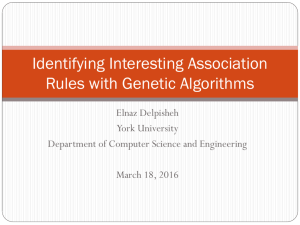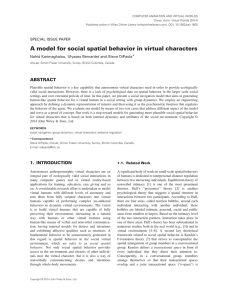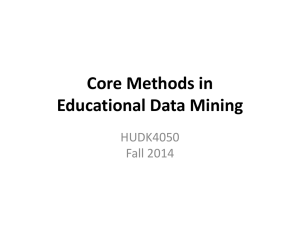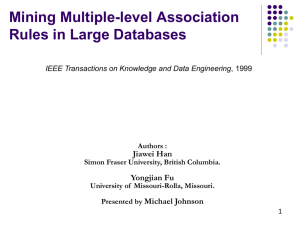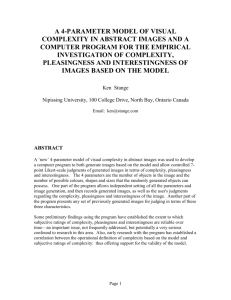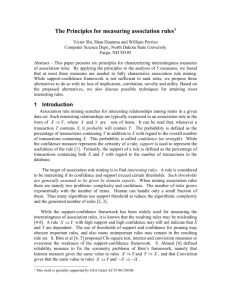Mining Interesting Rules in Bank Loans Data
advertisement
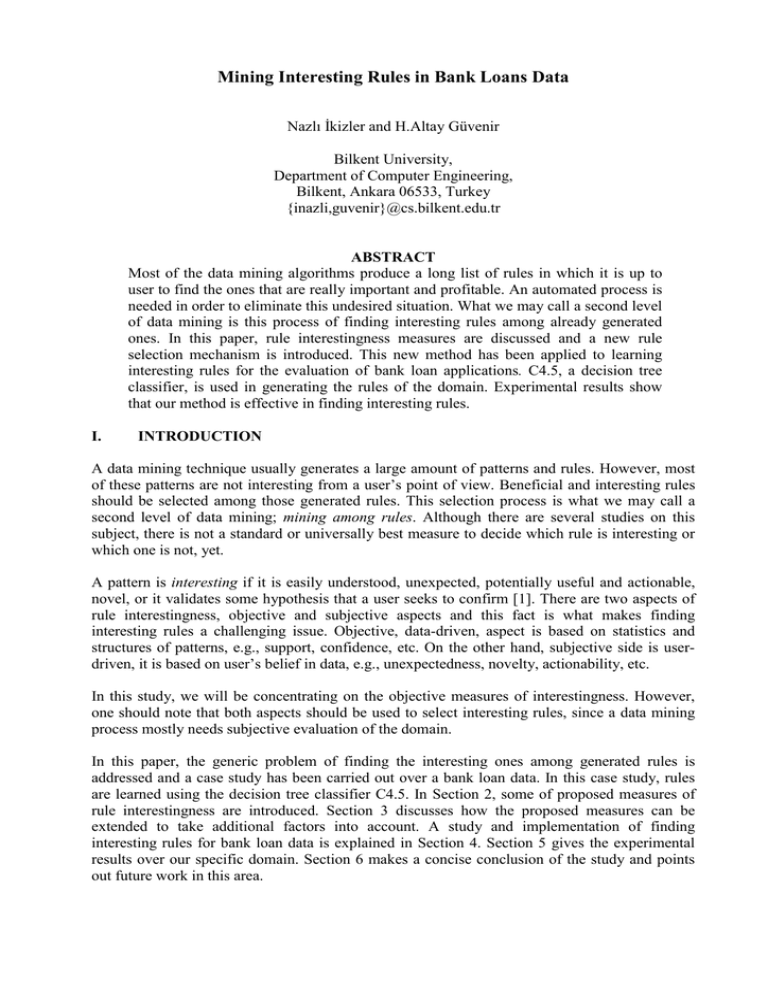
Mining Interesting Rules in Bank Loans Data
NazlÕøNL]OHUDQG+$OWD\*YHQLU
Bilkent University,
Department of Computer Engineering,
Bilkent, Ankara 06533, Turkey
{inazli,guvenir}@cs.bilkent.edu.tr
ABSTRACT
Most of the data mining algorithms produce a long list of rules in which it is up to
user to find the ones that are really important and profitable. An automated process is
needed in order to eliminate this undesired situation. What we may call a second level
of data mining is this process of finding interesting rules among already generated
ones. In this paper, rule interestingness measures are discussed and a new rule
selection mechanism is introduced. This new method has been applied to learning
interesting rules for the evaluation of bank loan applications. C4.5, a decision tree
classifier, is used in generating the rules of the domain. Experimental results show
that our method is effective in finding interesting rules.
I.
INTRODUCTION
A data mining technique usually generates a large amount of patterns and rules. However, most
of these patterns are not interesting from a user’s point of view. Beneficial and interesting rules
should be selected among those generated rules. This selection process is what we may call a
second level of data mining; mining among rules. Although there are several studies on this
subject, there is not a standard or universally best measure to decide which rule is interesting or
which one is not, yet.
A pattern is interesting if it is easily understood, unexpected, potentially useful and actionable,
novel, or it validates some hypothesis that a user seeks to confirm [1]. There are two aspects of
rule interestingness, objective and subjective aspects and this fact is what makes finding
interesting rules a challenging issue. Objective, data-driven, aspect is based on statistics and
structures of patterns, e.g., support, confidence, etc. On the other hand, subjective side is userdriven, it is based on user’s belief in data, e.g., unexpectedness, novelty, actionability, etc.
In this study, we will be concentrating on the objective measures of interestingness. However,
one should note that both aspects should be used to select interesting rules, since a data mining
process mostly needs subjective evaluation of the domain.
In this paper, the generic problem of finding the interesting ones among generated rules is
addressed and a case study has been carried out over a bank loan data. In this case study, rules
are learned using the decision tree classifier C4.5. In Section 2, some of proposed measures of
rule interestingness are introduced. Section 3 discusses how the proposed measures can be
extended to take additional factors into account. A study and implementation of finding
interesting rules for bank loan data is explained in Section 4. Section 5 gives the experimental
results over our specific domain. Section 6 makes a concise conclusion of the study and points
out future work in this area.
II.
RULE INTERESTINGNESS BASICS
A classification rule is in the form A ⇒ B where A is a conjunction of predicting attribute values
and B is the predicted class. Quality of the rule is mainly evaluated by looking at three factors,
namely coverage, completeness and the confidence of the rule. Coverage, denoted by |A|, is
number of tuples satisfied by rule antecedent. Completeness of the rule is |A&B|/|B|, the
proportion of number of tuples of the target class covered by the rule. The rule’s confidence
factor, in other words predictive accuracy of the rule, is given by |A&B|/|A|.
Piatetsky-Shapiro proposed three principles for rule interestingness (RI), which can be stated as
follows [2]:
1. RI = 0, if |A&B| = |A||B|/N (Here N is the number of tuples. Rule interestingness is 0 if rule
antecedent and rule consequent are statistically independent.)
2. RI monotonically increases with |A&B| when other parameters are fixed.
3. RI monotonically decreases with |A| or |B| when other parameters are fixed.
Freitas has pointed out five additional factors related to the interestingness of a rule [3]. These
are disjunct size, imbalance of the class distribution, attribute costs, misclassification costs and
asymmetry in classification rules. These factors are claimed to be important when designing a
domain-dependent rule interestingness measure.
Small disjunct problem, as it is addressed in [3], is related to the tendency of most data mining
algorithms to discover large disjuncts. This bias towards large disjuncts can eliminate very
important and interesting knowledge if not treated properly. Especially, in domains where small
disjuncts collectively match a large percentage of the tuples, this is an undesired situation. In
order to overcome this problem, small and large disjuncts should be evaluated in different ways.
In some of the domains, the tuples belonging to one class are much more frequent than the tuples
belonging to other classes. This is called imbalance of the class distribution. In such a case, the
smaller the relative frequency of a minority class, the more difficult to discover rules predicting
it. So, from the interestingness point of view, the rules predicting the minority class are more
interesting.
Freitas has also mentioned the fact that most rule interestingness measures consider the rule
antecedent as a whole. However, as he states, the interestingness of two rules having the same
coarse-grained value may be different, depending on the attributes occurring in the rules
antecedent. So, a good interestingness measure should consider attributes individually, according
to their specific properties that may be domain dependent. Attribute costs are one of these
properties. In some application domains such as medical diagnosis, different attributes might
have very different costs. In such a case, a rule whose antecedent consists of less costly attributes
are more interesting.
Misclassification cost is another issue, which should not be ignored when designing a good
interestingness measure. Especially in domains where misclassifying a case is highly crucial,
users of the domain are in need of a less risky classification system. In order to achieve such a
system, misclassification costs of the produced rules should be reasonable. In other words, the
smaller the misclassification cost of a rule, the more interesting it is.
The last factor that has been stated by Freitas is the asymmetry in classification rules. A rule
interestingness measure is said to be symmetric with respect to the rule antecedent and the rule
consequent. The reason for this is that we want to discover rules where the value of predicting
attributes determine the value of the goal attribute.
Besides all these, there are several other rule interestingness measures in the literature. Some of
these measures are discussed in [4]. Most of these measures depend on statistical factors such as
correlation. Lately, Tan and Kumar proposed another measure, called IS, which is again
derivable from statistical correlation [5]. We will revisit this measure in Section 3.
Another issue regarding the interestingness of the rules is the interaction between the rules.
Currently used techniques in data mining can generate redundant patterns along with the desired
ones. The generated rules can have the same semantic information, which we may call
overlapping of functions. In order to generate really useful and interesting rule patterns, these
rule interaction effects should also be taken into account by the rule selection mechanism.
III.
INTERESTING RULE SELECTION
As explained in Section 2, there are several factors that should be considered while determining
the interestingness of the generated rules. In this section, we discuss how these factors should be
evaluated and integrated into the rule selection mechanism. For this reason, we present a step-bystep schema to produce really interesting rules.
Pruning Redundant Rules
If the data mining technique used for extracting rules produces redundant rules, this redundancy
should be eliminated before calculating interestingness of rules. Here we may basically say a rule
is redundant if it satisfies one of the following two conditions:
1. If there are two implications of the form A → C and A & B → C, and both rules have similar
confidence values, then the rule A & B → C is redundant.
2. If there are two implications A → C and B → C, both have similar confidence values, then
B→ C is redundant if B is a subset of the conditions of A.
There may be other conditions besides the ones given above, but it is shown that most of the
redundant rules are detected by these two conditions [6]. Similar confidence values mentioned in
both situations are confidence values differing within a small range, e.g. 0.05. The first principle
says that if the addition of one condition to the rule antecedent does not affect the confidence of
a rule, then, addition of that condition is unnecessary. The second principle says that the subsets
of a generated rule are redundant if they are of the similar confidence strength.
If the two conditions given above are carefully observed, it is clear that the redundant rules are
not interesting from the user’s point of view, because they are mostly generated due to their
relation with the more general rules. Hence, in the interesting rule selection mechanism, the first
step should be pruning of these uninteresting rules.
Grouping by Coverage Values
The second step of determining the interesting rules should be grouping the pruned rules into
subgroups according to their coverage values. As it is noted in Section 2, small and large
disjuncts; i.e., the rules having low coverage (support) and rules having large coverage should be
evaluated in different ways. For this evaluation, Holte et al. suggested that small disjuncts should
be evaluated with a maximum-specificity bias, in contrast with the maximum-generality bias
favouring large disjuncts [7].
Tan and Kumar also argued that a good interestingness measure should take into account the
support of the pattern [5]. They have showed that their proposed IS measure can be used in the
region of low support, i.e., support of 0.3, whereas using RI measure in the region of high
support is preferred. Hence, in order to make small disjuncts as interesting as large disjuncts, we
may take IS measure as the basic measure for rules having coverage values in the range of
[0,0.3] and RI measure for rules with coverage values [0.3,1]. Here are the formulations for two
measures respectively:
P ( A, B ) P ( A, B )
P ( A) P ( B )
IS =
RI = P(A,B) – P(A)P(B)
In this paper, these two measures are experimented over bank-customers’ loans data individually
and results are presented in Section 5.
Misclassification Costs
So far, we have removed redundant rules and decided on the basic rule interestingness measure
based on the coverage of the rule. Now, we can consider other factors and build our
interestingness measure properly.
We have seen that misclassification costs are important for rule interestingness. A rule predicting
a patient does not have a particular disease while he indeed does is very risky and
misclassification cost of such a rule is very high. In domains where we cannot tolerate erroneous
classifications, a rule which has a low error rate and low misclassification cost is more desirable.
In order to integrate this inverse proportion to the rule interestingness calculations, we should
divide the basic rule interestingness measure by the misclassification cost of the rule, which is
defined as follows:
k
MisclasCost = ∑ Prob( j )Cost(i,j )
j =1
Here Prob(j) is the probability that a tuple classified by the rule has true class j, class i is the class
predicted by the rule and Cost(i,j) is the cost of misclassifying a tuple with true class j as class i
and k is the number of classes. Prob(j) can be calculated as follows, taking into account the effect
of disjunct size:
Prob(j) = (1 + |A&~B|)/(k + |A|)
Attribute Factors
In most of the interestingness measures, the rule antecedent is taken as a whole and interest in
the individual attributes is ignored. To overcome this situation, we should modify our
interestingness measure to take important attribute factors into account. For example, in some
domains attributes may have acquirement costs. In a medical diagnosis phase, the cost of getting
a computer tomography is much higher than determining the blood pressure. In such domains if
the prediction accuracy of two rules are similar, the rule with low attribute costs should be
preferred.
Freitas has proposed a term called attribute usefulness defined as the inverse of the sum of the
costs of all the attributes occurring in the rule antecedent, that is:
k
AttUsef = 1 / ∑ Cost(Ai)
i =1
where Cost(Ai) is the cost of the ith attribute occurring in the rule antecedent and k is the number
of attributes in the rule antecedent.
Besides attribute costs, there may be other factors related to attributes individually. For instance,
a user may be interested in specific attributes and rules containing those attributes. In that case
attributes may have different interest weights and the more the interest weights the more
interesting the rule is. In some domains, for example, one user may be interested in finding the
geographical causes of some disease, while another user is interested in finding effects of
demographical features.
Since the attribute factors are mostly domain specific, data mining experts should know about
these factors and should decide on the ones to include in the interestingness measure. If attributes
have different costs, the basic rule interestingness measure should be multiplied with Attribute
Usefulness measure. Other factors can be considered in a similar way.
Class Weights
Discovery of a particular class may be more interesting and useful for a data mining system in a
specific domain. For the rule selection mechanism, the classes can be given interest weights
beforehand and by this way, rules predicting classes with high interest rates can have larger
interestingness values. In order to accomplish this goal, rule interestingness measure can be
multiplied by the weight of the predicted class of the rule. Note that, as we mentioned above, if
no weights are specified the rules discovering the minority class are of higher interest than the
rules predicting the majority class.
IV.
FINDING INTERESTING RULES IN BANK LOANS DATA
In this study, the rule interestingness criteria mentioned above are applied to a real world
situation, where the data to be mined consists of bank customers who have borrowed some
amount loan from a particular bank.
Domain Description
In our experimentation domain, we are trying to predict whether a customer will pay the bank
loan back or not by looking at some information about the customer. The cases where the
applicants have paid their loan back are represented by class 0, while the others are class 1.
There are 13 attributes in our domain; 7 of these attributes are metric and 6 of them are nonmetric (categorical). The list of attributes and their types is given in Table 1.
Table 1. Attributes of the domain.
Type of Attributes
Name of Attributes
Age, Years in the same address, Years in the same job, Total
Metric
income, Credit amount, Credit/(Term*income), Fixed Term
Married, Have children, Have car, Have house, Occupation,
Home Place
Categorical
Training data of our data set consists of 1300 cases and 391 of these cases are of class 1 and
remaining 909 cases are of class 0. Test data consisted of 143 cases. The decision tree induction
algorithm C4.5 has been used in order to generate rules of the experimentation domain. As a
result, a total of 184 rules are generated by the standard. Then these rules are evaluated with the
rule interestingness criteria.
An example rule generated by the C4.5 algorithm is given below:
Rule 1:occupation = other
same_address <= 24
term <= 5
-> class 0 [96.8%]
where 1 represents the number of the rule, each line represents the conditions of the rule and the
last line shows the predicted class along with the confidence of the rule in the whole data set
(both in test and training data).
Experimental Details
In our domain, the attributes have no acquirement costs since they are mostly demographic
information. Also, the attributes are not given weights, since all attributes are of the same
interest. Although we are interested in predicting customers who are not likely to pay the money
back (class 1 instances), we do not assign any weights to classes either. Since class 1 is the
minority class in the data set, and rules predicting the minority class are already counted as more
interesting, assignment of weights to classes is not essential in our example domain.
It is obvious that classifying a customer as he will pay the money back, while indeed he will not
is much more costly than classifying a customer as he will not pay the money back, while he
will. In the former case, the bank will lose money whereas in the latter case it will lose profit. So
the assigned misclassification costs should be different in different cases and the costs assigned
in our experimentation is listed below in Table 2:
Table 2. Misclassification costs of the domain
Predicted
Actual
Class 0
Class 1
Class 0
0
2
Class 1
20
0
V.
EXPERIMENTAL RESULTS
Interestingness measures presented in Section 3 are applied to the loan applications domain.
Before we eliminate redundancy, first ten rules with their interestingness values in a sorted
decreasing order are presented Table 3. Here, all the interestingness values are calculated by
taking the RI measure as the basic measure.
Table 3. First ten interesting rules before pruning.
Rule Antecedent
Rule 5:credit_term_income <= 0.964258,
term <= 5
Rule 108:age <= 25, have_child = 0
Have_house = 0, credit_amount > 1073
Class
0
Coverage
263
Confidence
97.2
Interestingness
0.125879
1
28
90.9
0.107183
credit_term_income <= 0.256667, term > 8
Rule 86:credit_amount > 1073, term > 8
Rule 2:same_address <= 24, term <= 5
Rule 7:same_address <= 24, term > 2,
term <= 5
Rule 37:have_car = 0, credit_amount > 619,
home = BOLU
Rule 101:have_child = 1,
total_income<=1604,term>8,home=BOLU
Rule 61:married = 1, have_car = 0,
Home = BOLU
Rule 182: credit_term_income <= 0.18638
Term > 8, occupation = self_occupied
Rule 139: total_income > 612,
Credit_amount > 1073, term > 8
1
0
0
451
288
288
54.6
96.3
97.7
0.104145
0.097437
0.097437
1
18
92.6
0.096817
1
18
92.6
0.096817
1
17
92.2
0.086866
1
86
76.5
0.086866
1
331
54.8
0.078665
As it can be seen from Table 3, there are rules that are interacting with each other and user who
sees these rules will not be much surprised, because most of the rules capture the same semantic
meaning more or less. For example, Rule 2’s conditions are seen in Rule 7 and some of the rules
in the rest of the list. In this case, redundancy may exhaust the user, and we need a way to
eliminate this situation. In Table 4, the first ten interesting rules after the rule set has been pruned
are shown.
Table 4. First ten interesting rules after pruning.
Rule Antecedent
Rule 5:credit_term_income <= 0.964258, term
<= 5
Rule 108:age <= 25, have_child = 0
have_house = 0, credit_amount > 1073
credit_term_income <= 0.256667, term > 8
Rule 86:credit_amount > 1073, term > 8
Rule 37:have_car = 0, credit_amount > 619
Home = BOLU
Rule 101:have_child = 1, total_income <= 1604,
term > 8, home = BOLU
Rule 61:married=1, have_car= 0,home = BOLU
Rule 182:credit_term_income <= 0.186385,
term > 8, occupation = self_occupied
Rule 94:credit_amount <= 2095, term > 8,
Occupation = self_occupied
Rule 181:have_car = 0, term > 8,
Occupation = self_occupied
Rule 22:term > 5, occupation = self_occupied
Class
0
Coverage
263
Confidence
97.2
Interestingness
0.125879
1
28
90.9
0.107183
1
1
451
18
54.6
92.6
0.104145
0.096817
1
18
92.6
0.096817
1
1
17
86
92.2
76.5
0.086866
0.081106
1
73
78.2
0.078387
1
55
80.9
0.074192
1
123
69.1
0.071436
After pruning redundant rules rules, 139 rules are left, out of 184 rules. It is clear from Table 4
that, most of the redundancy is removed. Note that, the rules compared for redundancy have the
similar confidence strength. Here, a difference amount of 0.05 is used, however, if needed, this
pruning ratio can be made smaller or larger.
In Table 4, one important observation can be that the most interesting rule is the one belonging
to class 0 and also in the rest of the list, rules belonging to this class are in higher levels. This is
due to coverage grouping ratio of the interesting rule selection mechanism. In the first run, all
rules were evaluated with RI measure. If we put a coverage threshold 0.3 and evaluate rules
having coverage ratios more than this threshold with RI measure and rules with lower coverage
ratios with IS measure, resulting first ten rules are shown in Table 5.
Table 5. Rule coverage ratio 0.3 for RI and IS measures.
Rule Antecedent
Rule 37:have_car = 0, credit_amount > 619
Home = BOLU
Rule 101:have_child = 1, total_income <= 1604,
term > 8, home = BOLU
Rule 61:married = 1, have_car = 0,
home = BOLU
Rule 108:age <= 25, have_child = 0
have_house = 0, credit_amount > 1073
credit_term_income <= 0.256667, term > 8
Rule 112:have_child = 0, have_house = 0,
Credit_amount <= 1894, term > 8,
Occupation = self_occupied
Rule 5:credit_term_income <= 0.964258,
term <= 5
Rule 38:credit_amount > 619, home = ICEL
Rule 79:age > 26, have_child = 0, have_car = 1,
have_house = 0, term > 8, home = ISTANBUL
Rule 117:have_child = 0, have_car = 1,
have_house = 0, credit_amount > 1073,term> 8,
home = ISTANBUL
Rule 181:have_car = 0, term > 8,
Occupation = self_occupied
Class
1
Coverage
18
Confidence
92.6
Interestingness
2.145596
1
18
92.6
2.145596
1
17
92.2
1.980887
1
28
90.9
1.935342
1
15
91.2
1.664854
0
263
97.2
1.165264
1
1
26
11
85.6
88.2
1.110818
1.090238
1
11
88.2
1.090238
1
55
80.9
1.014917
It can be observed from Table 5 that our claim in Section 3 is true. By employing IS measure for
the rules having low coverage values, and RI for rules with high coverage values, the minority
class rules become more interesting (Rules predicting class 1 rise up in the interestingness list).
Further experimentation can help us to adjust this coverage ratio more properly.
The algorithm runs in O(n*m) time where n stands for the number of cases in the data set and m
is the number of rules in the rule set. It took 693msec for one run of our experimentation to
complete in a 60 MHz, SparcSTATION 20 machine.
VI.
CONCLUSIONS AND FUTURE WORK
In this study, we investigated the aspects of rule interestingness and discussed some criteria for
deciding on the best rule interestingness measure in the domain. An interesting rule selection
mechanism is proposed by combining those criteria in an effective manner. The initial
experimentation results of the rule selection in a bank customers’ domain are presented.
By the initial results, we see that pruning is an important part of the rule interestingness and
overlapping rule cases should be considered properly for the sake of novelty principle of rule
interestingness. Secondly, we see that, in domains where the rules predicting the minority class
are more important, coverage (support) values of rules should be taken into account and basic
rule interestingness measure should be decided according to those values. It is shown that using
IS measure with rules having low support and using RI measure with the rules having large
support brings out promising results.
For future work, different sizes of rule sets can be tested using our rule selection mechanism. As
stated above, different thresholds can be experimented and best results can be obtained.
Attributes and classes can be given weights and results can be compared. While determining
misclassification costs, different characteristics of the data can be evaluated and integrated to
misclassification costs. In any case, the most important action to take will be showing the
obtained results to users of the domain and get feedback about the rules’ real interestingness
values.
REFERENCES
[1] J. Han and M. Kamber “Data Mining: Concepts and Techniques”. Academic Press, pp.27,
2001.
[2] G. Piatetsky-Shapiro, “Discovery, Analysis and Presentation of Strong Rules”. Knowledge
Discovery in Databases, AAAI, 1991, pp.229.
[3] A.A. Freitas “On rule interestingness measures”. Knowledge-Based Systems, 12(5-6):pp.
309--315, October 1999.
[4] R.J. Hilderman and H.J. Hamilton “Knowledge discovery and interestingness measures: A
survey”. Technical Report CS 99-04, Department of Computer Science, University of Regina,
October 1999.
[5] P. Tan and V. Kumar, “Interestingness Measures for Association Patterns: A Perspective”.
Technical Report # TR00-036, Department of Computer Science, University of Minnesota, 2000.
[6] D.Shah, L.V.S. Lakshmanan, K. Ramamritham and S. Sudarshan, "Interestingness and
Pruning of Mined Patterns". ACM SIGMOD Workshop on Research Issues in Data Mining and
Knowledge Discovery (DMKD), May, 1999.
[7] R.C. Holte, L.E. Acker, B.W. Porter “Concept Learning and the Problem of Small
Disjuncts”, Proceedings of the International Joint Conference on AI (IJCAI-89), pp. 813-818.
